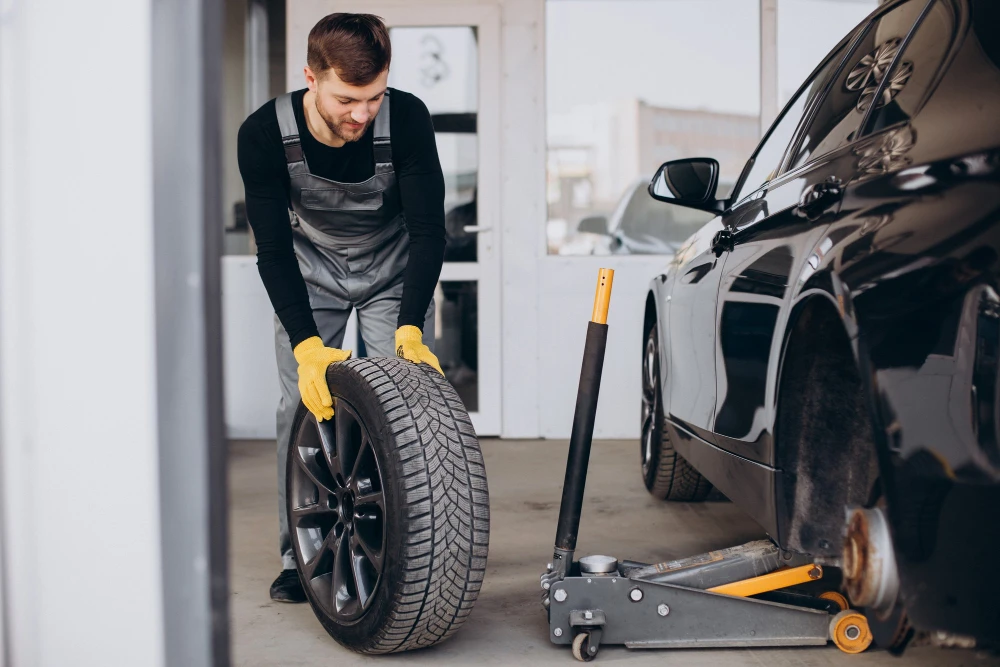5.Tread Depth
The tread on your tyres should never fall below 1/16 of an inch (1.6 millimeters) in depth. If you regularly drive on slick, wet surfaces, you’d be even better off with twice that much. You can buy a gauge to measure the tread depth the way the professionals do, but there’s an old trick that will give you a rough idea of how much tread depth you have left and it won’t cost you more than a penny.
In fact, it requires a penny. Take a Lincoln-head penny, the kind you find in your change every day, and insert Abe’s head (head-down) into the tread. If Lincoln’s entire head remains visible, you don’t have enough tread. Take your car into the mechanic and ask about getting a new set of tyres.
4.The Tread Wear Indicator Bar
Newer tyres have a convenience that older tyres lacked. They have tread wear indicator bars built into the tyres themselves. These bars, invisible or barely visible when the tyres are new, gradually begin to appear as the tread wears down. They appear as flat rubber bars running perpendicular to the direction of the tread itself. If more than one or two of these are visible on a tyre, the tread is getting low. This should be particularly obvious in the wet tracks that your tyres leave after you drive through a puddle. Use the penny test described on the previous page to double check the depth, but if the bars are starting to appear on any or all of your tyres, it’s once again time to check with your mechanic or local tyre dealer to see about getting your current tyres replaced.
3.Cracks in the Sidewall
Not all problems with the tyres are going to be in the tread. They can also appear in the sidewall. Fortunately, it’s easy to do a visual check of sidewall problems. Look for tracks or cuts in the sidewall — grooves that are distinct enough to be visible to the naked eye. This could be a sign that your tyre is developing a leak (or worse, that it’s nearly ready to blow out). This is definitely something you want to avoid. So if the cracks in the sidewall are starting to look serious, get that car to a repair shop at the next opportunity and start talking about getting them replaced. Better safe than sorry, as they say.
2.Bulges and Blisters on the Tyre
Sometimes the outer surface of the tyre begins to weaken. The result can be a bulge or blister that extends outward from the rest of the surface. This is similar to an aneurysm in one of your blood vessels and you know that if your doctor tells you that you have an aneurysm, you’d better get to the hospital as quickly as you can before you blow out an artery. It’s the same with your tyre. This weak spot can cause a sudden blow out, and if you don’t put the car in the hospital (or service center, as the case may be) before this happens, it may end up putting you in the hospital when the tyre blows out on the freeway. So keep your eye on those tyre bulges and blisters.
1.Too Much Vibration
A certain amount of vibration is inevitable when driving, especially on poorly paved roads, but if you’ve been driving for a while, you probably know how much vibration feels right and how much means that something’s going wrong. There can be any of a number of causes for the vibration — maybe your tyres are misaligned or unbalanced, or your shock absorbers are starting to go. But it could also indicate that there’s some sort of internal problem in the tyre itself. Even if the tyre isn’t the root cause of the vibration, the vibration could damage the tyre and pretty soon you’ll have a problem. So if your car has a bad case of the shimmy-shimmy shakes, especially if you notice this when you aren’t driving on bad roads, take it to the mechanic right away to have it checked out. Too much vibration is almost always a sign that something is wrong.
LinkedIn: https://www.linkedin.com/company/finixx-global-industry-co-ltd-?trk=company_logo






